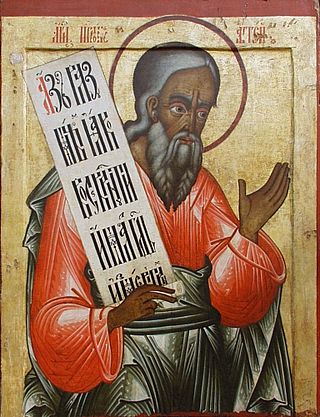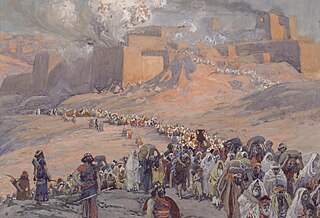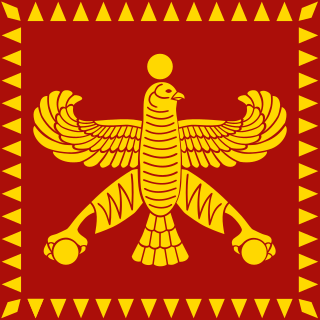Related Research Articles
The Book of Ezra is a book of the Hebrew Bible; which formerly included the Book of Nehemiah in a single book, commonly distinguished in scholarship as Ezra–Nehemiah. The two became separated with the first printed rabbinic bibles of the early 16th century, following late medieval Latin Christian tradition. Composed in Hebrew and Aramaic, its subject is the Return to Zion following the close of the Babylonian captivity. Together with the Book of Nehemiah, it represents the final chapter in the historical narrative of the Hebrew Bible.
The Book of Nehemiah in the Hebrew Bible, largely takes the form of a first-person memoir by Nehemiah, a Jew who is a high official at the Persian court, concerning the rebuilding of the walls of Jerusalem after the Babylonian exile and the dedication of the city and its people to God's laws (Torah).
The Book of Joel is a Jewish prophetic text containing a series of "divine announcements". The first line attributes authorship to "Joel the son of Pethuel". It forms part of the Book of the twelve minor prophets or the Nevi'im ("Prophets") in the Hebrew Bible, and is a book in its own right in the Christian Old Testament. Joel is not mentioned elsewhere in either collection.
The Book of Nahum is the seventh book of the 12 minor prophets of the Hebrew Bible. It is attributed to the prophet Nahum, and was probably written in Jerusalem in the 7th century BCE.
The Book of Haggai is a book of the Hebrew Bible or Tanakh, and is the third-to-last of the Twelve Minor Prophets. It is a short book, consisting of only two chapters. The historical setting dates around 520 BC before the Temple had been rebuilt. The original text was written in Biblical Hebrew.
The Book of Malachi is the last book of the Neviim contained in the Tanakh, canonically the last of the Twelve Minor Prophets. In most Christian orderings, the grouping of the prophetic books is the last section of the Old Testament, making Malachi the last book before the New Testament.

Ezra or Esdras, also called Ezra the Scribe in Chazalic literature, and Ezra the Priest was an important Jewish scribe (sofer) and priest (kohen) in the early Second Temple period. In Greco-Latin Ezra is called Esdras. His name is probably a shortened Aramaic translation of the Hebrew name עזריהו Azaryahu, "Yah helps". In the Greek Septuagint the name is rendered Ésdrās, from which the Latin name Esdras comes.

Haggai or Aggeus was a Hebrew prophet during the building of the Second Temple in Jerusalem, and one of the twelve minor prophets in the Hebrew Bible and the author of the Book of Haggai. He is known for his prophecy in 520 BCE, commanding the Jews to rebuild the Temple. He was the first of three post-exile prophets from the Neo-Babylonian Exile of the House of Judah, who belonged to the period of Jewish history which began after the return from captivity in Babylon. His name means "my holidays."
The Nevi'im is the second major division of the Hebrew Bible, lying between the Torah ("instruction") and Ketuvim ("writings"). The Nevi'im are divided into two groups. The Former Prophets consists of the narrative books of Joshua, Judges, Samuel and Kings; while the Latter Prophets include the books of Isaiah, Jeremiah, Ezekiel, and the Twelve Minor Prophets.

The Babylonian captivity or Babylonian exile is the period in Jewish history during which a large number of Judeans from the ancient Kingdom of Judah were captives in Babylon, the capital city of the Neo-Babylonian Empire, following their defeat in the Jewish–Babylonian War and the destruction of Solomon's Temple in Jerusalem. The event is known to be historical, and is described in the Hebrew Bible in addition to archaeological and extra-biblical sources.

According to the biblical narrative, Zerubbabel was a governor of the Achaemenid Empire's province of Yehud and the grandson of Jeconiah, penultimate king of Judah. Zerubbabel led the first group of Jews, numbering 42,360, who returned from the Babylonian captivity in the first year of Cyrus the Great, the king of the Achaemenid Empire. The date is generally thought to have been between 538 and 520 BC. Zerubbabel also laid the foundation of the Second Temple in Jerusalem soon after.
The Minor Prophets or Twelve Prophets, occasionally Book of the Twelve, is a collection of prophetic books, written between about the 8th and 4th centuries BCE, which are in both the Jewish Tanakh and Christian Old Testament.
Apocalyptic literature is a genre of prophetical writing that developed in post-Exilic Jewish culture and was popular among millennialist early Christians. Apocalypse is a Greek word meaning "revelation", "an unveiling or unfolding of things not previously known and which could not be known apart from the unveiling".
According to Jewish tradition the Great Assembly was an assembly of 120 scribes, sages, and prophets, which existed from the early Second Temple period to the early Hellenistic period, roughly coinciding with the Persian hegemony over the nation of Israel. The assembly's members, known as Anshei Knesset HaGedolah, traditionally included such figures as Haggai, Zechariah, Malachi, Ezra, Nehemiah, Daniel, Hananiah, Mishael, Azariah, Mordechai and Zerubbabel.
The Prophecy of Seventy Weeks is the narrative in chapter 9 of the Book of Daniel in which Daniel prays to God to act on behalf of his people and city, and receives a detailed but cryptic prophecy of "seventy weeks" by the angel Gabriel. The prophecy has been the subject of "intense exegetical activity" since the Second Temple period. James Alan Montgomery referred to the history of this prophecy's interpretation as the "dismal swamp" of critical exegesis.
A Biblical genre is a classification of Bible literature according to literary genre. The genre of a particular Bible passage is ordinarily identified by analysis of its general writing style, tone, form, structure, literary technique, content, design, and related linguistic factors; texts that exhibit a common set of literary features are together considered to be belonging to a genre. In Biblical studies, genres are usually associated with whole books of the Bible, because each of its books comprises a complete textual unit; however, a book may be internally composed of a variety of styles, forms, and so forth, and thus bear the characteristics of more than one genre.

The return to Zion is an event recorded in Ezra–Nehemiah of the Hebrew Bible, in which the Jews of the Kingdom of Judah—subjugated by the Neo-Babylonian Empire—were freed from the Babylonian captivity following the Persian conquest of Babylon. After their release, the Persian king Cyrus the Great issued a proclamation known as the Edict of Cyrus that enabled the freed Jewish populace, exiled from Judah, to return to Jerusalem and the Land of Judah, which had begun to function as a self-governing Jewish province under the Achaemenid Persian Empire.

Yehud, also known as Yehud Medinata or Yehud Medinta, was an autonomous administrative province of the Achaemenid Persian Empire. It was one of several such provinces in Palestine, with the others being Moab, Ammon, Gilead, Samaria, Ashdod and Idumea, constituting the fifth Persian satrapy of Eber-Nari. Located in Judea, it continued to exist for two centuries before it was incorporated into the Hellenistic empires following the Wars of Alexander the Great.

Ezra 5 is the fifth chapter of the Book of Ezra in the Old Testament of the Christian Bible, or the book of Ezra–Nehemiah in the Hebrew Bible, which treats the book of Ezra and book of Nehemiah as one book. Jewish tradition states that Ezra is the author of Ezra–Nehemiah as well as the Book of Chronicles, but modern scholars generally accept that a compiler from the 5th century BCE is the final author of these books. The section comprising chapter 1 to 6 describes the history before the arrival of Ezra to the land of Judah in 468 BCE. This chapter records the contribution of the prophets Haggai and Zechariah to the temple building project and the investigation by Persian officials.
References
- ↑ Anthony R. Ceresko, "Jonah" in New Jerome Biblical Commentary Ed. Raymond E. Brown, Joseph A. Fitzmyer, and Roland E. Murphy. Prentice Hall: Englewood Cliffs, NJ, 1996. pp. 580-584.
- ↑ Louis F. Hartman and Alexander A. Di Lella, "Daniel" in New Jerome Biblical Commentary Ed. Raymond E. Brown, Joseph A. Fitzmyer, and Roland E. Murphy. Prentice Hall: Englewood Cliffs, NJ, 1996. pp. 406-420.